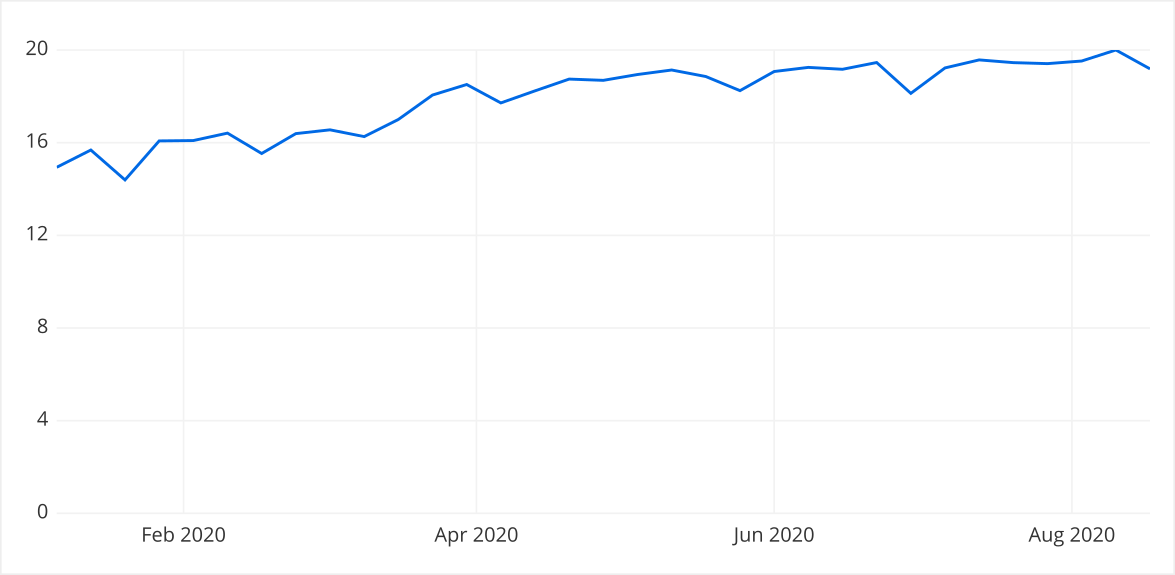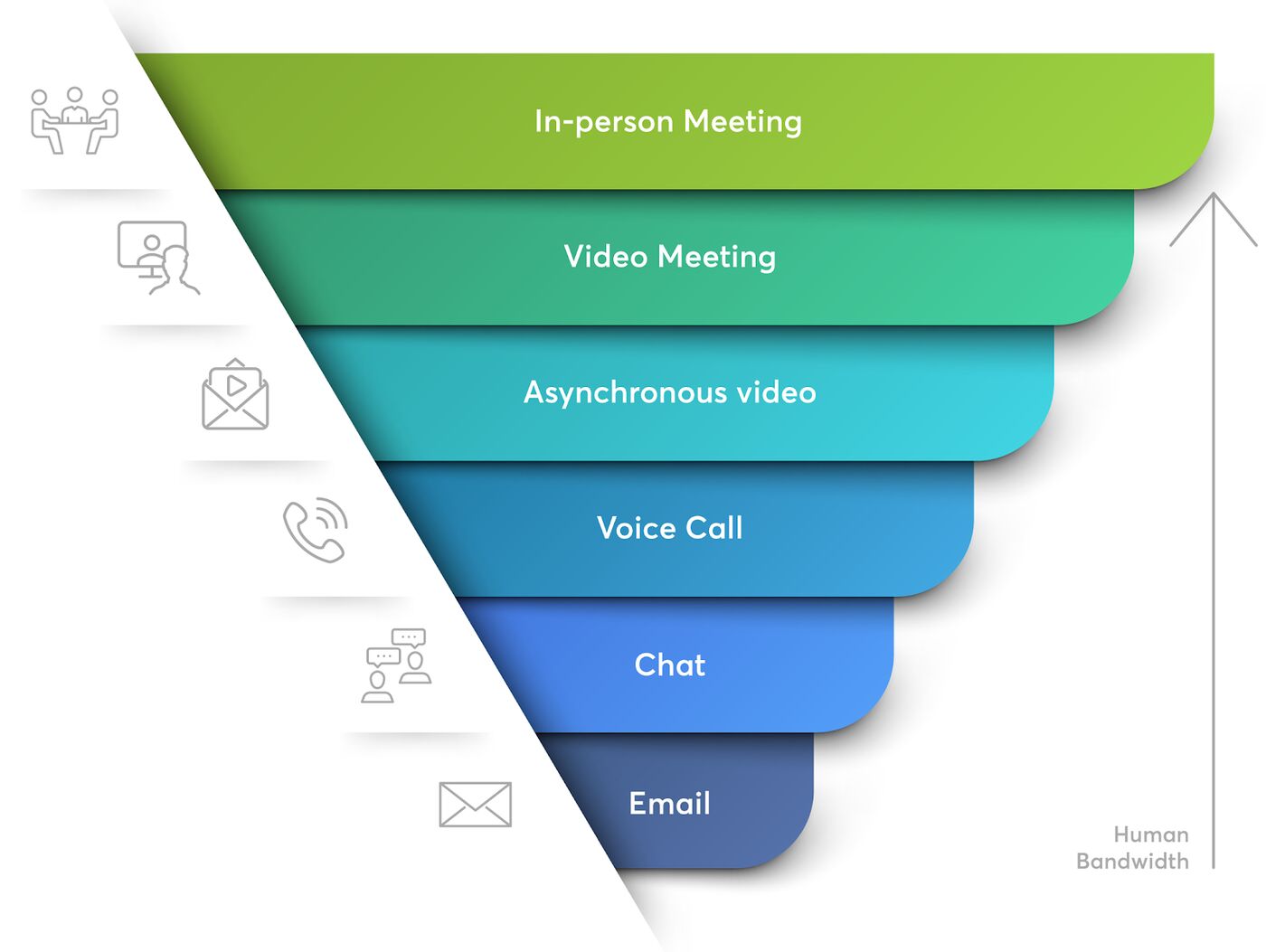As the team behind Hugo, the leading meeting notes platform, you won’t be surprised to hear that we love meetings. But what may surprise you is that one reason we love meetings is because we don’t have many.
Using asynchronous communication instead of real-time meetings can dramatically improve the efficiency of your company, but how do you decide which meetings to eliminate?
We’ve looked at the data from thousands of companies through our analytics, surveys, and research. We know the companies with the best cultures and most effective meetings are those that appropriately manage human attention and bandwidth. Put simply, they make meetings work for them — not the other way around.
So, without further ado, let’s look at the specific steps you can take to use the right communication method at the right time.
The impact of communication bandwidth on how we work
The instinct to meet seems to be built into the human psyche. Our recent research showed that despite lockdown, the average number of meetings per week didn’t budge. Face-to-face meetings went down, but there was a parallel increase in online conference calls.

In other words, if your co-located company already had a culture of meeting too often, working from home didn’t change a thing. Existing meetings were transformed into calls and new meetings were added in an attempt to replicate the synchronous workplace communication many team members were used to. For global teams, this might have even been a boon, because you could more easily include people outside of working hours.
But at this point, everyone has virtual meeting fatigue, and workers in remote time zones are getting tired of having no time that is off-limits for meetings. It’s time to reassess your communications options.
We think about communication in terms of bandwidth. The following chart shows the progression of communication bandwidth. At the top, you have the activity that provides the most bandwidth: in-person meetings. Here, communication is much richer than just words; it includes forms of nonverbal communication like body language, expression, and tone. At the bottom you have email, where you lose every nuance other than a few words.
The trade-off between the two extremes is communication quality versus effort. Higher bandwidth communication enables you to communicate more than just the words, and lower bandwidth communication can be achieved with lower costs (time, travel, and technology).

With so many channels competing for our attention at work, it’s tempting to push our communication further down the bandwidth spectrum. It’s quicker and easier, and it gives us control of the schedule and the words. At the same time, nuance is typically lost when you attempt important conversations or collaboration via lower-bandwidth communication. Trying to regain that nuance in our interactions is the key driver of the meeting explosion we’re witnessing.
Take a look at the meetings on your calendar and consider them in light of the pyramid of communication bandwidth. Meetings play an important part in building any team, but they’re not the only high-bandwidth option available.
To thrive in this new world of remote-first collaboration, you need to be tactical about how you communicate and when. The trick is to master synchronous vs asynchronous communication. Will a Slack message do, or are you better off sending a Loom video conveying the great idea you came up with last night? Can you give feedback on that recent report via video, or should you get on a Zoom call to discuss together with your team? Do you need to attend the meeting or can you wait for notes and tasks to be shared?
These decisions and trade-offs represent mastery of the pyramid. Efficient collaboration and a great meeting culture is therefore a function of how well you choose the communication forum.
Related reading: 11 Essential Communication Skills for the Workplace — The Loom blog
To meet or not to meet
Meetings are costly. A recent study estimated meetings in the United States to cost almost $400 billion per year. Meetings can interrupt your workflow, inconvenience people in different time zones, or fall on top of people’s most productive times. The more people involved, the more expensive the meeting.
Meetings should be reserved for what we call “The Three Ds” — debate, discussion, and decision-making. Sharing information, providing updates, communicating ideas, and giving feedback don’t necessarily need to be done synchronously.
Again, take a look at your calendar. How many of your meetings fall into “The Three Ds” category? For those that don’t, could you achieve their objectives asynchronously?
To assess whether you can eliminate the meeting in favor of asynchronous communication, check the following five factors:
1. Title
The fastest way to determine if a meeting is necessary is to look at the title. Check out the word cloud below, based on the titles of meetings we tracked over hundreds of companies soon after COVID-19 hit. We took 100,000 anonymized meeting titles from Hugo users’ meetings in April 2020, soon after the effects of the pandemic were felt. We then did some basic processing to identify the words and phrases that came up more than others to get an understanding of the types of meetings that were most common during the rapid shift to remote work and the related impacts on workplace operations and culture.

How many of these activities could be completed asynchronously? If it’s an update, demo, review, catch-up, or sync, it probably can be done with a video, or perhaps a written update. Just by looking at the titles, you may have eliminated half of your meetings — but what if those weekly meetings are where your team makes decisions? Read on …
2. Time
The amount of time dedicated to the meeting is another indicator of meeting value. Is the meeting always the same amount of time every week? Is your meeting scheduled for more than 60 minutes? Were the agenda items designed to “fill” the hour, or could a shorter meeting handle the critical ones? All of these signs point to a meeting that can be shortened or avoided.
3. Outcomes
Every meeting should have a clear purpose and outcomes which together set the objective for the meeting. We refer to this as the meeting’s purpose, further described in our Vital Meetings Handbook. The absence of a clear purpose or uncertain outcomes is a strong indicator of an avoidable meeting.
4. Attendees
Once you decide to conduct the meeting, the next step is to invite attendees. Attendees are only those people who have important information or perspectives for the debate, discussion, or decision. People who just need to be informed can be informed through the distribution of meeting notes. They don’t need to attend. Sometimes, you’ll find that using this criterion leaves you as the only person in the meeting — in other words, you get to use asynchronous communication.
5. Cost
Finally, there’s assessing the cost of not meeting. What if you made the decision yourself without consulting others? If there aren’t any serious consequences or the cost of everyone’s time outweighs these consequences, then don’t have the meeting.
By the way, don’t neglect the “switching cost,” which is the amount of time it takes for people to switch their attention from one task to another. Studies show it takes 20 minutes for people to get back into a task once they’ve been interrupted, and shifting between tasks can cost as much as 40% of one’s productive time. That means that when you call a meeting for 30 minutes, the time for each person to participate may be more than an hour, including their prep time and the time to refocus on their work when the meeting ends.
Managing the trade-off
While costly and often avoidable, meetings can provide an unparalleled opportunity to facilitate high-quality discussion, establish culture, and make decisions. What’s changed as of late is the availability and effectiveness of asynchronous communication. Just a few years ago, the communication bandwidth pyramid would have been flatter, forcing us to choose between sending an email or holding a meeting. Now, we have many more options.
The businesses succeeding with productive, collaborative teams are able to maximize communication bandwidth through both synchronous and asynchronous communication. The tools of effective communication aren’t simply interchangeable — each tool has a particular strength. Knowing how and when to meet and choosing the right tool at the right time will increase your efficiency and allow you to enjoy the few meetings that are left on your calendar.

